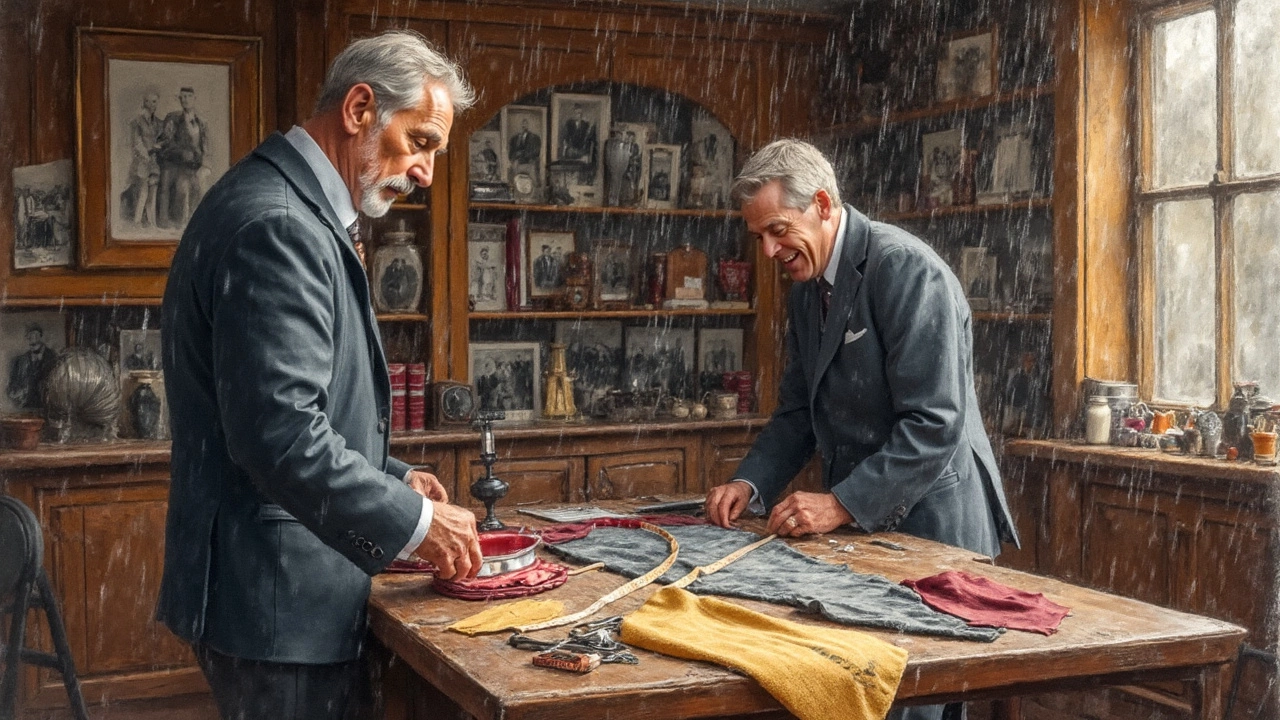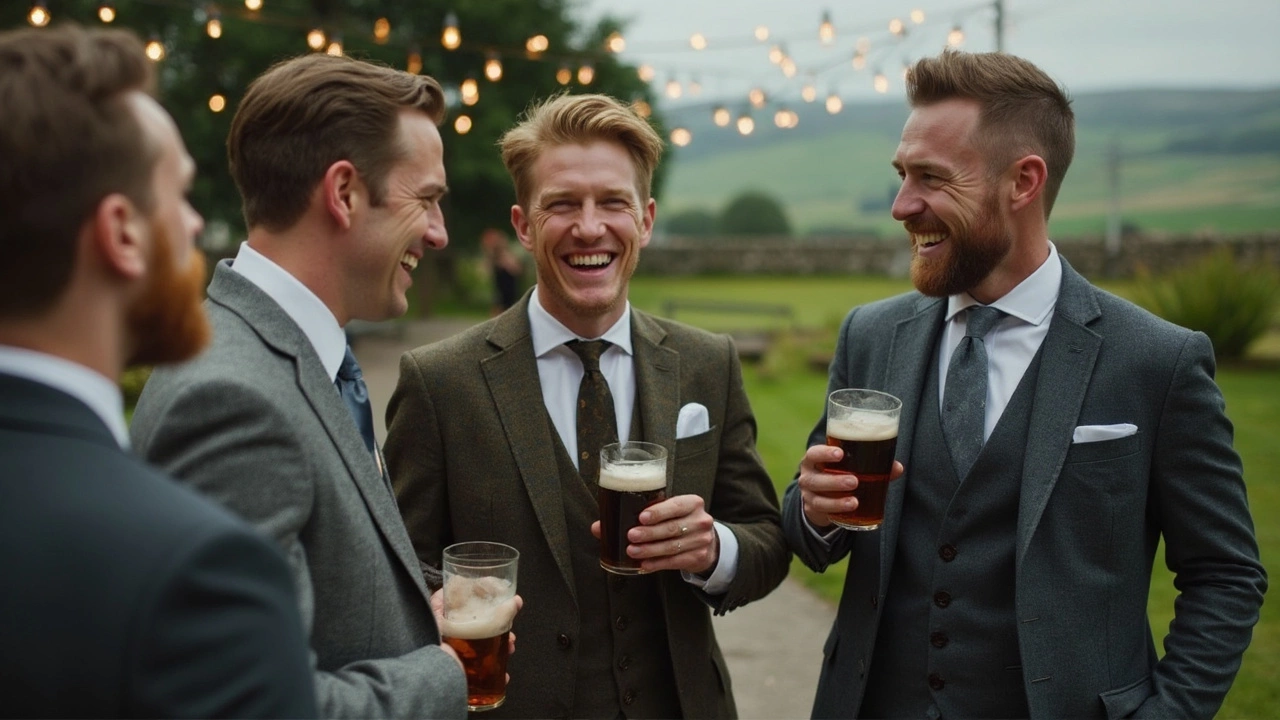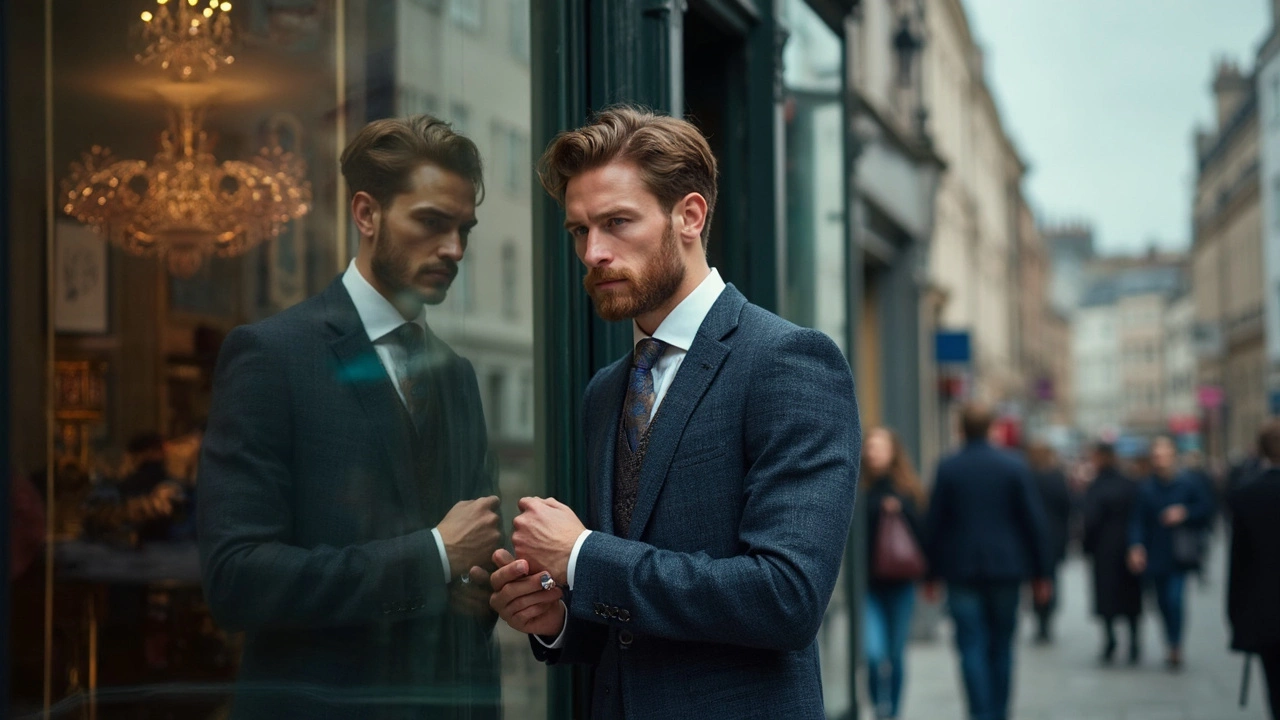If you’re walking into a pub in Galway or an office in Dublin, people in Ireland can tell pretty quickly if your suit is the real deal or just faking it. Here’s what sets an expensive-looking men’s suit apart—and no, it’s not some label that hardly anyone in Ireland recognises.
It starts with how the suit fits you. You can spot a rental from a mile away—shoulders baggy, trousers bunching, sleeves swallowing the hands. Spend your money getting the fit sorted, either by buying off the peg and then having a local tailor (like those tucked away on South Anne Street in Dublin) do their magic, or go straight for made-to-measure. Even in smaller towns, ask around because there’s usually a trusted tailor who’s been fixing wedding suits for years.
Material is the next giveaway. Irish weather is tricky—drizzly, windy, always changing—so you want a fabric that doesn’t crease at the first sign of rain. Pure wool works best, especially those woven in Donegal (look for Magee 1866). Cheaper polyester blends tend to shine under lights, and nothing says “cheap” like a shiny lapel at a family party. And yes, Irish people do run their hand down your sleeve if they suspect it’s not real wool.
- Irish Taste: What Sets an Expensive Suit Apart
- Fabric That Feels Right for Ireland
- The Tailor’s Touch: Fit Is Everything
- Finishing Touches: Details Irish People Notice
- Where to Find Quality Suits in Ireland
Irish Taste: What Sets an Expensive Suit Apart
Ask anyone who’s rocked a men's suit in Ireland: it’s not just the price tag that makes a suit look expensive. Locals pick up on cues that might not even cross your mind. A suit that blends into Grafton Street crowds is usually built on a handful of core things, and yes, a good chunk of it comes down to fit and detail—flashy branding rarely impresses here.
First up, Irish taste puts a massive weight on subtlety. Nobody’s wearing head-to-toe Lombard Street flash unless they want side-eye. Sharp, balanced proportions—like lapels that aren’t too skinny or too fat—score points. Irish blokes often prefer a jacket that hugs the shoulders without pinching, sleeves ending just above the wrist so a sliver of shirt shows. Short arms or long torso? Irish tailors will quietly fix that, as locals notice these details right away.
Colour matters too. Navy and charcoal dominate for work, weddings, and nights out in Ireland’s bigger cities. Black is often left for funerals or formal black-tie events. You’ll see checks or subtle patterns come autumn, especially in counties like Donegal or Mayo, but nothing that screams for attention. The fabric’s drape and the way it holds up after sitting for a pint—these details catch the Irish eye. Suits that crease badly or look limp after a couple of hours are a dead giveaway.
If you sit at a wedding in Killarney or stand at a networking event in Cork, little things make a huge difference: trousers just brushing the tops of your shoes, buttons lying flat, pockets not bulging with random clutter. Most Irish men wouldn’t be seen dead with sleeves longer than their shirt. The whole look should say you spent time, not just money.
- Fit: Tailored to the body, especially shoulders and sleeves.
- Fabric: High-quality wools (like Magee or John Hanly) are prized.
- Colour: Navy, charcoal, and muted checks win over garish options.
- Finishing: Decent buttons, tidy stitching, and no loose threads.
- Occasion savvy: Lighter shades for spring races at Fairyhouse, heavier fabrics for winter weddings.
Locals don’t get bowled over by expensive brands, either. If a suit just looks right and feels good, nobody cares much if it’s not from some big-name fashion house. That’s what sets apart an expensive-looking men's suit Ireland style—common sense, a sharp eye, and a good tailor behind the scenes.
Fabric That Feels Right for Ireland
Picking the right fabric isn’t just about looking good—it’s about not being caught freezing or sweating buckets because you picked a suit meant for Miami, not Mullingar. In men's suits Ireland market, pure wool is king. Irish weather changes every five minutes, so you want something breathable when you end up running for the Luas or standing outside for a smoke at a wedding.
Wool—especially from local names like Magee or Foxford—handles rain, wind, and even the odd sunny spell. Donegal tweed is iconic, and not just for old-school headgear. It has texture, depth, and tiny flecks of colour that set you apart from every bloke in a plain navy number. Suits in these fabrics hold their shape and shrug off wrinkles. They're also warm when you need it without suffocating you indoors.
Avoid suits that feel plasticky or look shiny, like those polyester blends you spot in clearance racks. They might look alright under the harsh shop lights, but get them into real daylight or a crowded pub and they’ll give away their price tag—fast. Plus, those cheaper fabrics don’t handle the typical Irish downpour and will end up feeling clammy in ten minutes flat.
- Pure wool: Best for year-round wear. Holds shape, resists creasing.
- Wool-silk blend: Bit of sheen, great for special occasions, but pricier.
- Donegal tweed: Iconic Irish option. Ideal for country weddings or anything outdoors.
- Linen-wool blend: Good for warmer months, but watch for wrinkles. Usually okay around Ireland in July and August.
Some Irish guys pick heavier tweeds or flannel for winter, especially for December weddings or work in chilly courtrooms. Lighter worsted wool is solid for all-year, especially if you’re hopping between meetings in Dublin city or taking the DART out to Howth after work.
If you’re on the fence, visit an actual fabric shop or tailor and feel the fabric. Most staff in Irish shops are honest—they’ll tell you straight if something will last two wash cycles or stick to your back in August.
Here’s a quick look at how popular suit fabrics handle typical Irish weather:
| Fabric | Rain Resistance | Breathability | Season |
|---|---|---|---|
| Pure Wool | Good | Excellent | All Year |
| Donegal Tweed | Very Good | Good | Autumn/Winter |
| Linen-Wool Blend | Low | High | Summer |
| Polyester Blend | Poor | Poor | Avoid |
So if you want a luxury suit that lasts in the Irish climate, stick with natural fibres—and give the cheap blends a miss, no matter how tempting the discount.

The Tailor’s Touch: Fit Is Everything
Nobody in Ireland is fooled by an expensive label if the suit’s hanging off your shoulders. When it comes to men's suits Ireland shoppers put fit right at the top of the essentials list. No matter how much you spend, a suit that doesn’t fit will always look cheap, and a well-fitted, mid-range suit can look like it costs twice the price when it fits just right.
Take the shoulders first—this is where so many lads get it wrong. The seam should land perfectly at the edge, never drooping past or riding above. Irish streets are full of men swimming in jackets that were bought 'for comfort', but the result is untidy. Tailors around Dublin, Cork, and Limerick see this mistake all the time. The truth is, when the shoulders fit, everything else can be tweaked easily.
Next up, the jacket’s length. Forget what you’ve seen on American TV—suit jackets should roughly hit your knuckles when your hands are at your sides. Too long and you look like you’ve borrowed your uncle’s suit for Confirmation Day. Too short and you strut in looking like you’re off to a teenage disco rather than the boardroom.
You want trousers that break just once on your shoes and aren’t pooling around your ankles. This small adjustment alone moves a suit from "grand" to "spot on." Especially in Ireland, where rain can turn extra fabric at the hem into a soggy mess.
There are proper tailoring spots to seek out: Louis Copeland & Sons is a Dublin institution, known for getting the details right. If you’re in Galway, check out Martin Feeney Tailors—he’s a favourite for wedding suits and business gear alike. Many suit shops even offer tailoring on-site. Don’t be afraid to use it. You’re not fussy, you’re smart.
If you’re unclear if your jacket or trousers fit, just ask for a proper fitting session. Good tailors in Ireland will always pace around you, pinning tiny bits here and there. It’s not for show. It’s their job to make your suit blend with your shape and lifestyle. The final result? You look taller, sharper, and confident—without saying a word.
- Check jacket shoulders: seam should sit right at the tip
- Jacket length: knuckle rule when hands rest naturally
- Sleeve length: about a half inch of shirt cuff showing
- Trousers break once, not puddling
- Slim, neat lines—no pulling or bagging when buttoned
A couple of numbers to keep in mind: a survey by Irish retailer Louis Copeland found that 77% of men who tailored their suits felt more confident at work and events, while 64% believed people treated them with more respect compared to wearing off-the-rack suits. It’s not just about looks; it’s about how the right fit changes how you’re seen, especially in Irish fashion circles.
Finishing Touches: Details Irish People Notice
You can have the best men's suit in Ireland, but if you miss the small things, people spot it straight away. Irish folks are sharp-eyed when it comes to details. For starters, buttons matter a lot. Real horn or mother-of-pearl buttons feel and look more solid than cheap plastic ones. If your cuff buttons aren’t working ones (surgeon cuffs), it shouts "off the rack," and you’ll see some old lads at a wedding quietly rolling their eyes.
Stitching is another giveaway. Neat, even stitching around your lapels and pockets shows care. Look out for pick stitching (tiny visible stitches)—you’ll see this on quality suits from places like Louis Copeland in Dublin. If you spot loose threads, walk away. And always check the lining. Full lining helps the suit hold shape in Ireland’s windy weather, but half-lining or unlined jackets can work in the summer. If the lining is a mad print, fair enough, just make sure it’s stitched down smooth.
Even the smallest finishing touch—like pocket squares, tie bars, or how a tie knot is done—gets noticed. Irish business events and even the odd christening or confirmation see more men adding a personal touch, but don’t go mad with flashy colours or novelty cufflinks (unless you’re in Galway during the Arts Festival—there, anything goes). Classic white pocket squares, navy or deep green ties, and leather belts keep things sharp.
- If the trousers have unfinished hems, get them sorted at a tailor—puddling fabric at the ankles kills the look.
- Shirts should be crisp and fit well—nothing peeking out from under the suit sleeve except a slim line of cuff.
- Shoes must be real leather and polished—scuffed trainers with a suit is a no-go, unless you’re a Leaving Cert student doing your debs in the RDS.
And don’t forget the weather. Because of the rain, lots of Irish men choose a suit with a tight weave so water rolls off, and invest in a decent umbrella (look for Fox Umbrellas at Brown Thomas if you want to spend a few quid). It’s the kind of thing people mention in passing, but quietly judge if you turn up soaking from a cheap €5 brolly snapping in the wind.

Where to Find Quality Suits in Ireland
You don’t have to hunt the globe for top-notch men's suits in Ireland—some of the best are right here, on your doorstep. Dublin’s got a solid mix of classic and modern options. Louis Copeland & Sons is basically an institution, with expert tailoring in town for decades. They’ll sort you out whether you need a suit for work or a big family wedding. Suits Distributors in Cork is great if you want something sharp but don’t have a sky-high budget. It’s also worth checking out Anthony Ryans in Galway, especially if you want proper advice from folks who know their stuff.
For off-the-peg but still solid quality, Brown Thomas on Grafton Street usually carries popular names like Hugo Boss and Ted Baker. If you’re aiming for Irish-made, Magee 1866 stands out—wool from Donegal with cool heritage twists that go down well at both business events and casual parties. Their suits have this texture that just lasts through Irish weather and long nights.
Now, if your frame or tastes don’t fit what’s already hanging in shops, there are some top services for made-to-measure suits. Diffney does it really well, and you’ll find branches in Dublin and Bray. For a full bespoke job, check out Tom Murphy in Cork—they walk you through fabric, lining, and even those tiny details like button choice.
If you’re based outside of big cities, check locally—lots of family-run men’s outfitters still dot small towns across Ireland. Often, they’ll partner with experienced tailors or offer their own in-house tweaks. This makes all the difference for that perfect fit.
| Shop Name | Location | Specialty |
|---|---|---|
| Louis Copeland & Sons | Dublin, Galway, Cork, Limerick | Tailoring, luxury brands |
| Magee 1866 | Donegal, online, major cities | Irish wool, heritage suits |
| Diffney | Dublin, Bray | Made-to-measure, modern fit |
| Suits Distributors | Cork | Value, variety |
| Brown Thomas | Dublin, Cork, Galway, Limerick | Designer labels |
No matter where you shop, always ask if in-house tailoring is included or extra. A quick sleeve or trouser adjust can turn a good buy into a showstopper. And if it feels like the shop doesn’t care about the fit, just walk out—there’s plenty of choice for Irish fashion that actually looks and feels expensive.
